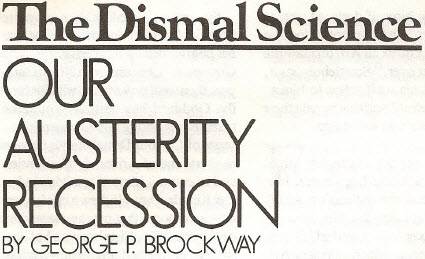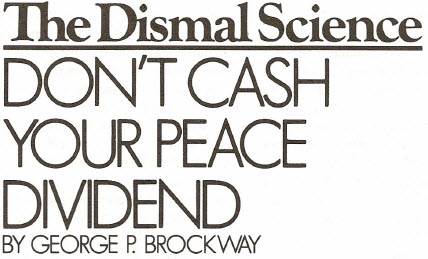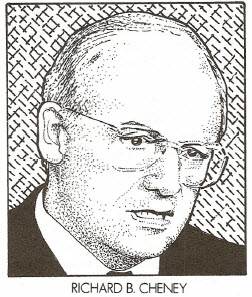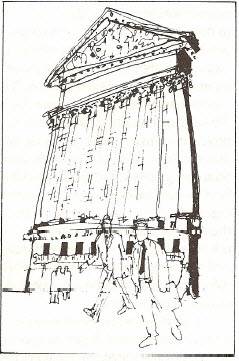By George P. Brockway, originally published January 14, 1991
FINANCIAL EXPERTS are saying that the present recession was caused by consumers failing to consume. The supply side supplied, but the demand side didn’t demand. I’ll go along with that; but I’m dismayed that the supply-siders seem to have learned nothing from the experience.
I have just finished a decennial purging of what I whimsically refer to as my files; they were crowding me off my desk, much as the Federal deficit is said to crowd entrepreneurs out of the credit market. As the clippings and offprints fluttered into my wastebasket, I was struck by the volume and vehemence of those complaining that we Americans consumed too much or didn’t save enough (take your pick).
For 20 or 30 years now, all the respectable bankers (once upon a time every banker was respectable), all the respectable journalists, all the respectable economists have been moaning about how we Americans have been on a consumption binge. (If you want the facts of the matter, ask the Economic Policy Institute, 1730 Rhode Island Avenue, NW, Washington, DC 20036, for a detailed refutation by Robert A. Blecker.) Ronald Reagan’s Right-wing revolution was supposed to exalt the supply side over the demand side. There were tax cuts for the rich and tax increases for the poor, because the poor would only waste their money by buying things they needed or maybe wanted, while the rich would invest theirs in Wall Street and make capital gains. Austere elements of the far Left joined in the chorus (of course, for ostensibly different reasons). Consumerism got a bad press wherever you turned. Sometimes it seemed that Ralph Nader was more subversive than the Chamber of Commerce believed him to be.
Among the worthies represented in the clippings I threw out were at least four Nobel laureates, one former chairman of the Federal Reserve Board, three former chairmen of the Council of Economic Advisers, six former Secretaries of the Treasury, one former Secretary of Commerce (who seems to have started a new anti-consumption committee every other week), a past chairman of the Committee for Economic Development, nine officers or staffers of the Brookings Institution, almost everyone who has ever set foot inside the American Enterprise Institute, innumerable other professors and journalists and TV pundits, not to mention Presidents and Senators and Representatives and unsuccessful candidates for those offices. The idea has had its spokesmen in the International Monetary Fund and the World Bank (where it is known as austerity), as well as in Britain, France, Italy, Germany, Norway, Japan, and Kenya. It has not suffered from lack of publicity.
The present failure of consumers to consume is just what these doctors ordered. Some of the doctors-those who still believe in the efficacy of purging and bloodletting – are no doubt pleased with the resulting recession. A few are puzzled and silent. But most are as noisy as ever.
Many of the respectable economists, I shudder to say, were bashing consumption in the name of Keynes. They seem not to have noticed that he concluded Chapter 6 of The General Theory with these words: “the conception of the propensity to consume will, in what follows, take the place of the propensity or disposition to save.”
Classical economists had long held that consumption was a drag on investment. Back in 1803, Jean-Baptiste Say wrote in words that could be applauded today by Newt Gingrich, “It is the aim of good government to stimulate production, of bad government to encourage consumption.” The reasoning was simple. What is spent on consumption can’t be invested in production. Obviously. Keynes also agreed with the proposition-with one proviso: There has to be full employment. Not 4, 5 or 6 per cent unemployed, but really, truly, full employment. In that case, and in that case only, with the economy running flat out, nothing more can be produced; so whatever labor goes for one thing can’t at the same time go for something else. But with millions of men and women unemployed, it is always possible to increase production by giving them jobs.
What I don’t understand is how the notion that consumption is bad got started. If consumption is bad, then production must be, too. I’m used to writing jeremiads that nobody takes seriously (someday they’ll be sorry), but why should tens or hundreds of thousands of people be expected to band together to make automobiles if nobody is supposed to buy and drive them?
The consumption thing (to use a Presidential locution) is another of those fallacies of composition economists keep perpetrating. An individual who saves his money (even hiding it under the hearth) is more likely to die rich than someone who flings roses riotously with the throng. But if everyone in the land sits home, wasting not and wanting not, the economy runs down, and no one has anything to consume, or to save, either.
The consumption thing is vastly more threatening because the government is doing its best to participate. Look at what Gramm-Rudman-Hollings has done to us. As a result of the budget deal of a couple of months ago, the Federal government is committed to spending 30 or 40 billion dollars less next year than it had planned (conservatively) to spend, and the cuts will be greater in succeeding years. A considerable part of the “savings” will be at the expense of the states and municipalities, all of which are already short of funds because of the recession, and all of which are traumatized by childish and self-defeating taxpayers’ strikes. In order to balance their budgets, the states will have to cut down on their services – and that is simply another way of saying they will have to fire people. School class sizes will rise, and bridges will fall.
Taken as a whole, the government part of the consumption thing means that, one way or another, at least a million people will lose their jobs. Some of the affected will no doubt be those dreadful goldbricking bureaucrats we keep hearing about, but most will be employees of private business – a.k.a. free enterprise – for the government is the private economy’s greatest single market for goods and services. The billions of dollars the private economy will lose because of Gramm-Rudman-Hollings will make the recession both deeper and harder to climb out of.
FACED WITH this dismal prospect, a rational Congress would repeal Gramm-Rudman-Hollings, a rational President would sign the repealer, and together they would embark on a massive public works program. Everyone knows there is plenty to be done and plenty of people to do it. But everyone knows nothing of the sort will happen because of the deficit.
 Suppose our reaction to Pearl Harbor had been similar. In 1941 the Federal government was running a deficit equal to 4.3 percent of GNP. It jumped to 14.4 per cent in 1942 and to 31.1 per cent in 1943. Thereafter it fell, but remained above 7. 5 percent as late as 1946, and averaged 18 per cent over the six war-time years.
Suppose our reaction to Pearl Harbor had been similar. In 1941 the Federal government was running a deficit equal to 4.3 percent of GNP. It jumped to 14.4 per cent in 1942 and to 31.1 per cent in 1943. Thereafter it fell, but remained above 7. 5 percent as late as 1946, and averaged 18 per cent over the six war-time years.
In contrast, consider the current deficit and its steadily rising estimates. Last February the Economic Report of the President presented figures predicting a deficit of 1.1 per cent of GNP, while according to the latest estimate of the Congressional Budget Office, the deficit will be at least 5.4 per cent of GNP.
Had we taken deficits in this range as cause for inaction in 1941, we would have run up the white flag no later than December 11, when Germany declared war on us. And we would have spent the succeeding 39 years studying Japanese and German industrial management from the ground up.
It is no answer to say that there was a war on. Indeed there was, and we came out of it with total Federal indebtedness equal to 127.3 per cent of GNP – more than double today’s comparable figure. Yet when the War was over we set about rehabilitating Europe and ultimately did so with the Marshall Plan, at a cost to us, in 1990 dollars, in excess of $250 billion (see “Don’t Cash Your Peace Dividend,” NL, March 19, 1990).
Did we ruin ourselves by this profligacy? Hardly. It was not until 1975 – almost 30 years later – that the unemployment rate became as high as it is today. Aside from the flash inflation caused by precipitate lifting of price controls (over Harry Truman’s veto), it was not until 1974 that the Consumer Price Index rose at its present rate. Furthermore, after-tax profits as a percentage of GNP were higher than today’s in every postwar year except three Nixon-Ford years (1974, 1975and 1976) before Jimmy Carter appointed Paul A. Volcker chairman of the Federal Reserve Board in 1979.
Since then our mirror has cracked from side to side, and the curse of inaction has come upon us. That is what the record of unemployment, of inflation and of after-tax profits shows. It won’t do to point a finger at OPEC (see “What Happened to Jimmy Carter,” NL, November 27, 1989). Some blame falls upon us for what we did because of OPEC that is, nothing much (and as I write we threaten to go to war in its defense). But the major blame falls upon us for casually and stupidly embracing the fallacy that a nation can save itself into a healthful economy.
If we could disabuse ourselves of this fallacy, the current recession would not last long, and the subsequent prosperity would show up the alleged prosperity of the past decade for the pallid fraud that it was. Unfortunately, those who urged the fallacy upon us continue to push it; we continue to follow them; and as a result the recession will be deeper and longer than necessary.
The New Leader






